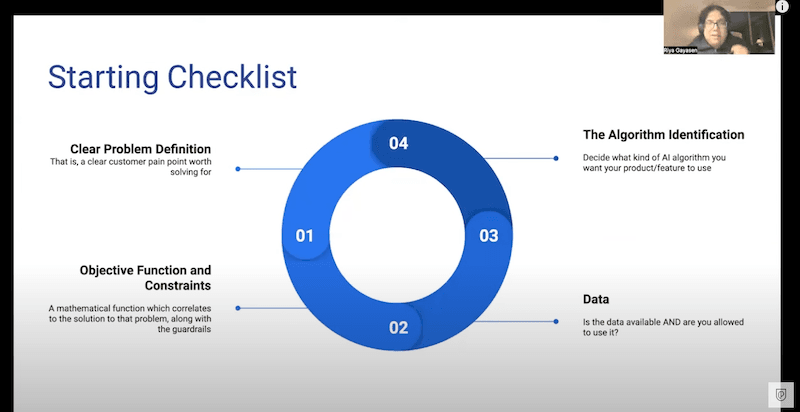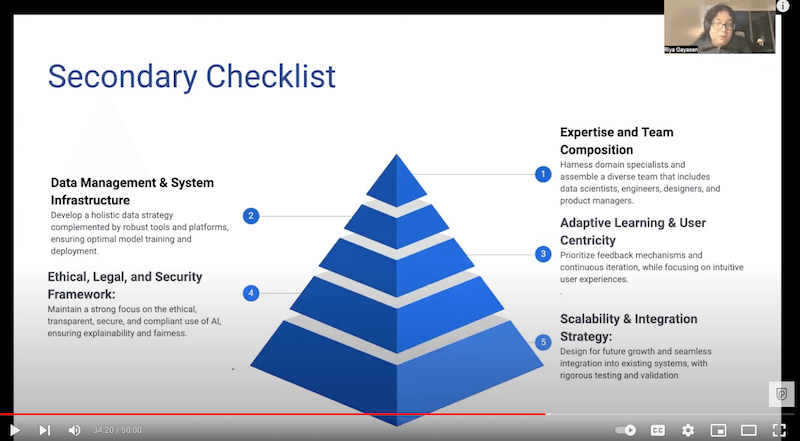Updated: April 25, 2024- 10 min read
Whether it's enhancing user experiences, streamlining processes, or solving complex problems, AI holds immense potential. But before investing time and money into developing AI features, think carefully.
In this guide, you’ll discover the key concerns you should consider before incorporating AI features into your product. (Plus discover some handy free resources for anyone wanting to become a Product Manager for AI or machine learning products!)
To do this, we'll delve into four main topics that are key to your success:
Defining what a product is: While you might already be well-versed in the topic, it's essential to ensure we're all on the same page regarding the definition of a product.
Value-Driven AI Integration: Don’t add AI to your product just because it’s trending. With real-world examples, you’ll learn the importance of making AI integration user-driven and user-centric. Plus discover the three steps you must take before adding AI features.
Technical Feasibility: If you've decided to incorporate AI into your product, you'll need to make sure it’s technically feasible. In this section, you’ll find two essential checklists to ensure that you can successfully implement AI capabilities.
Ethics in AI and Bias Mitigation: Lastly, we'll delve into the critical topic of ethics in AI and how to mitigate potential biases that can arise, particularly when algorithms are influenced by biased data.
Throughout this journey, we'll draw on insights from industry experts and real-world examples to illustrate the dos and don'ts of AI integration. We're not just scratching the surface; we're delving deep to empower you with the knowledge and insights needed to make informed decisions about adding AI features.
So, whether you're a tech enthusiast, a product manager, or an innovator seeking to harness the transformative potential of AI, fasten your seatbelt. Our deep dive into AI features is about to begin, and it's going to be an enlightening ride!
Editorial note: This post is based on the talk What AI Features to Add to Your Product by PayPal Senior PM, Riya Gayasen, and contains additional insights and examples from the Product School team. You can watch the webinar in full below.
What is a product?
We use products every day. Laptops, mobile phones, toothpaste, and coffee mugs—all of these are products. But how do we define a product?
In short, a product is anything that solves a problem. Consider a ladder, a simple contraption made of wood and rope. When you purchase a ladder, what are you paying for? Are you simply acquiring a piece of wood and rope, or are you buying access to a higher place, allowing you to reach your objective? This concept is rooted in the Jobs-To-Be-Done framework, which defines a product as something that performs a specific task or job for you.
Similarly, think about a drill. When you purchase a drill, you're not just acquiring a piece of steel and electronics; you're investing in the ability to create a hole in your wall. This hole, in turn, serves a purpose, such as hanging a TV or a painting. Therefore, a product is fundamentally something that fulfills a particular function or job in our lives.
It's essential to keep this definition of a product in mind when discussing AI products. AI should ultimately serve a purpose and address real problems, aligning with the core concept of what a product is.
Free Value Proposition Canvas
Learn how to take user problems as the foundation of your solution and only build products that matter with our free Value Proposition Canvas!
Get Yours Now
Value-driven AI integration
Keeping the definition of a product in mind, let’s dive into the concept of value-driven AI integration.
When we talk about value-driven AI integration, we mean that AI features should be added based on their potential to solve specific problems rather than just for the sake of innovation.
In other words, don't add an AI feature simply because it's AI; think about the real use case it needs to address. Your decision to include an AI feature should be rooted in its ability to meet user needs effectively.
Adding an AI feature that doesn't align with users' needs or fails to solve their problems can lead to a less-than-optimal user experience. It might even confuse users. A valuable product is one that genuinely solves a user's problem, whether it includes AI or not.
Value-driven AI features in action
Let's look at some real-world examples of value-driven AI features:
Chatbots: Many websites implement chatbots to help customers find answers or complete tasks. When well-designed, these chatbots provide significant value by enhancing the user experience.
Spotify's “Discover Weekly” Feature: This feature utilizes AI to make music recommendations based on user behavior. It enhances the user's music discovery experience, demonstrating how AI can add real value.
Apple's Face ID: Face ID offers a seamless login experience by recognizing the user holding the phone. It's a prime example of AI delivering a superior user experience.
Now, let's consider hypothetical examples of AI features that may not be entirely value-driven:
Home Security System: Imagine an AI-powered system that detects suspicious movement around a house. While the concept sounds promising, if it frequently generates false alarms due to inadequate testing and a lack of robustness, it can lead to desensitization and a negative user experience.
Fitness App: Suppose a fitness app introduces AI-driven health recommendations without first addressing basic issues like inaccurate step counting or syncing problems with smartwatches. Users may find it difficult to trust the AI recommendations when fundamental features aren’t working correctly.
In these examples, implementing AI for innovation's sake without considering fundamental user needs can lead to suboptimal outcomes. It's crucial to prioritize the basics and ensure that your product meets essential requirements before adding AI features.
3 steps you need to take before adding an AI feature
Define Pain Points: Identify users’ pain points through methods like user interviews, root cause analysis, and stakeholder mapping. This step is fundamental in any product design process.
Consider Human Solutions: Ask yourself how a human would solve these identified problems effectively. This step helps bridge the gap between user needs and potential AI solutions.
Consider Scale: Can AI can assist in scaling up the solution? When considering this, don’t just consider increasing the size, or helping a greater number of people affected by the problem, consider quality. Specifically, you need to assess whether AI can effectively solve the problem better than a human being.
Only when you can confidently answer "yes" to all these questions should you seriously consider adding an AI feature to your product.
Read more about being an AI Product Manager in this article.
Technical Feasibility
Once you’ve ensured that adding AI features adds value to your product, you need to determine whether they’re technically feasible to implement and align with your product's goals.
To do this, answer the following four questions:
Do you have a clear problem definition? This question is key for product managers, as it ensures that the problem you're addressing is a genuine pain point and that your solution is valuable enough for users to actively seek out your product.
What are the objective functions and constraints? AI algorithms are essentially mathematical functions that optimize for specific mathematical quantities. You can't just instruct an AI algorithm to "give the right recommendation" without defining what "right" means mathematically. Constraints are equally important, setting limits on what the AI can or cannot do.
Do you have the data and are you allowed to use it? Data may be subject to regulations or may contain sensitive information. It’s crucial to ensure that you have the right to use it ethically and legally.
What kind of AI algorithm do you want your product/feature to use? AI algorithms range from simple linear regression models to neural networks and decision trees. The choice of algorithm should align with your data and problem statement, and this decision should be made early in the process to determine how you process the data.

Once you've addressed these primary questions, you can move on to a secondary checklist, represented below as a pyramid.
Do you have a team capable of implementing the AI algorithm? Having the expertise and resources to write the necessary code is fundamental to AI feasibility. You’ll need to harness domain specialists and assemble a diverse team that includes data scientists, engineers, designers, and product managers.
Do you have a data strategy in place, both for initial training data and for continuously ingesting new data? Data is the lifeblood of AI, and you need a system to manage it effectively.
Do you have a feedback mechanism in place to incorporate continuous feedback into your AI system? AI algorithms may make mistakes initially, and feedback is crucial for improvement. You’ll need to prioritize feedback mechanisms and continuous iteration while focusing on intuitive user experiences.
Have you established an ethical, legal, and security framework for your AI system? Compliance with privacy laws, data security, and ethical data usage are essential considerations.
Do you have a strategy for scalability and integration? Ensuring that your AI system can integrate seamlessly with your existing application is crucial to avoid future maintenance challenges.

Ethics in AI and Bias Mitigation
Last but not least, let’s consider some of the ethical issues that can arise when using AI – a crucial consideration when deciding whether to AI features to your product.
In many instances, AI algorithms may inadvertently introduce biases, and even if the algorithm itself isn't biased or inaccurate, errors can arise from the data it trains on. To illustrate this, let's delve into an example:
Consider an AI-based medical imaging app designed to diagnose skin conditions from photographs. This app relies on a dataset containing images labeled as either healthy or indicative of specific skin conditions. The AI algorithm is trained using these images, learning to classify new photographs.
However, the real world is diverse, and the app encounters a wide range of skin colors in practice. Ideally, it should make accurate diagnoses for all users, but biases can emerge if the training dataset lacks diversity. If one demographic is overrepresented and another is underrepresented, the AI algorithm may struggle to accurately diagnose the underrepresented group, leading to potential misdiagnoses.
Such biases can have serious consequences, particularly in healthcare, where misdiagnosis can lead to severe outcomes. These biases can contribute to health disparities, with certain demographics receiving inadequate care due to AI system inaccuracies.
The underlying reason for these biases often stems from a lack of representation in the training data. Traditional medical resources, such as textbooks and image banks, may contain limited images, often skewed toward specific demographics, creating a bias in the AI's training data.
The solution lies in diversifying the training data. Engage with communities globally to collect a wide range of images representing diverse skin colors. Additionally, establish robust validation protocols to detect and rectify biases in the AI system. Healthcare professionals, including doctors and nurses, must also be aware of potential biases and misdiagnoses by AI systems to compensate for these challenges.
Updated: April 25, 2024




